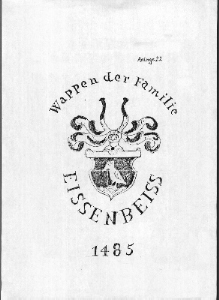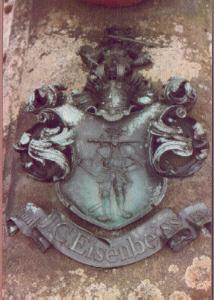



| 
| 
|
En Français:
En 1485 l'empereur Frederick III donne à la famille EISENBEISS
les armes que l'empereur Wenceslas alors roi de Bohème avait
offertes à un groupe de 9 chevaliers.Elles montrent un pic blanc
sur un rocher noir au sommet d'une colline située dans un près
jaune. avec deux cornes noire et blanche.Le feuillage est noir
et blanc. A la fin du 18° siècle la classe moyenne put récuperer
ses armes dont la plupart avait disparues et qui furent
retrouvées gràce aux travaux de N.Pohl, alors Graveur à la
cour de Prusse.
In English:
The family originates in Bavaria. The coat of arms was granted by Emperor Friedrich III ca. 1482 after it was created in Emperor's Wenzeslas' time in 1379 by nine knights. It shows a white woodpecker on a black rock in a golden shield with above it a small black field and a helmet with two half black, half gold horns. Garlands are of gold and black colour. These coats of arms which granted by Emperor Wenzeslas were for ordinary citizens as well as noblemen until Emperor Ferdinand II made coats of arms the prerogative of nobility. All non noble families had to give up their coats of arms, but these were recorded in the Emperor's archives in Vienna and published in 1696 at Nuremberg under the name of greater Europe. When at the end of last century the prerogatives of the nobility ceased, ordinary people were again permitted to have a coat of arms which in most families were lost and with assistance from the present work were re-discovered. In it is found the coat of arms of the family Eissenbeiss.
The books are the property of N. Kohl, Royal Prussian court engraver in Cologne.
In Germany, it was the practice to award Wappen to a family of an individual, such that all direct heirs are allowed to use it. This differs from the convention observed in Great Britain where it is only legal and socially acceptable for the individual to which the Coat of Arms was issued to bear them.
Auf Deutsch:
Die Familie stammt aus Baiern. Das Wappen wurde gegeben von Kaiser Friedrich III, Anno 1482, nachdem dasselbe Anno 1379 unter Kaiser Wenzeslaus von neun rittermäßigen Männern gestiftet worden war. Dasselbe enthält einen weiß Specht auf schwarzem Fels im goldnen Schild mit Oben einem Kleinem schwartzem Feld, darüber den Helm auf welchem sich qweib halb gold, halb schwarze Hörner befindet. Die Laubwerke erhalten die Farben gold und schwarz.
Diese Wappen welche unter Kaiser Wenzeslas gestiftet worden waren, führten die bürgerlichen so gut auch die Adeligen, bis unter Kaiser Ferdinand II das Wappentragen ein Vorrecht des Adels wurde.
Damals, kamen in sämtlichen bürgerlichen Familien die Wappen ab, wurden jedoch in Wien in Archiv des Kaisers verzeichnet, und im Jahre 1696 zu Nürnberg unter dem Namen der großen Europa. Wappensammlung veröffentlicht.
Als nun Ende des vorigen Jahrhunderts die meisten Adelsvorrechte aufhörten, durften auch die bürgerlichen wider ihre Wappen führen, dieselben waren jedoch in den meisten Familien verloren worden und nur mit Hülfe vorstehenden Werks konnten sie wieder aufgefunden werden. Ebendaselbst findet sich auch das Wappen der Familie Eißenbeiß vor.
Die Bücher sind im Besitz von N. Pohl königl. preuß. Hofgraveur in Cöln.
There is a legend that goes with this
Arms that says the woodpecker featured on
the shield returns each year and sharpens
it's beak on the hill. At the end of 1000 years, the
hill will be completely worn away, and at that time all
Eisenbeiß will perish the earth!

|
The image on the left is from the tombstone of J.C.Eisenbeiss, plot number 1403 in Johannisfriedhof, Nürenberg (St. John's Cemetery, Nürnberg). The caption on the bottom says:
"Familie, J.C. Eisenbeiss, 1894".
Johannisfriedhof, Nürenberg |
I wish to extend special "Thank you" to Klaus Halbig of Nürnberg for obtaining the detailed information on this grave.

On the right is the image as it appears on the act of purchase of the mill of Wellesweiler, near Neunkirchen (Saarland). Click here for the text of the Act of Purchase.
The image also appears on a stelestone in Felsberg (southwest of Saarlouis).
En Français:
Ces chevaliers devaient entrainer les combattants à la bataille et par
leur accoutrement,une épèe à la bouche une autre dans la main droite ils
provoquaient l'adversaire.Dans le vieux cimetière de Johannis à
Nuernberg existe une tombe construite vers 1600,avec une sculpture
représentant ces deux chevaliers.Ce dessin se trouve aussi sur
l'acte du moulin d'achat,
de Wellesweiler à coté de Neunkirchen,
moulin acheté par Seyfried Eisenbeiss
le 25 septembre 1697.
In English:
These knights have had to entail soldiers to the battle and by
their equips, a sword in the mouth, another in the right hand,
to boast ahead adversaries so as to provoke them.
In the ancient cemetery, Johannis Grabe, of Nuernberg, exists a
tomb constructed in 1600 with a sculpture representing these two
knights. This drawing is also found under a form of engraving
on the act of purchase
of the mill of Wellesweiler,
near Neunkirchen (Saarland) by Seyfried Eisenbeiss,
September 25,1697.
Auf Deutsch:
[coming soon]
This page last updated 16 Jan 1998